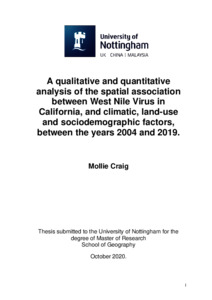Craig, Mollie
(2021)
A qualitative and quantitative analysis of the spatial association between West Nile Virus in California, and climatic, land-use and sociodemographic factors, between the years 2004 and 2019.
MRes thesis, University of Nottingham.
![A qualitative and quantitative analysis of the spatial association between West Nile Virus in California, and climatic, land-use and sociodemographic factors, between the years 2004 and 2019. [thumbnail of A qualitative and quantitative analysis of the spatial association between West Nile Virus in California, and climatic, land-use and sociodemographic factors, between the years 2004 and 2019.]](https://eprints.nottingham.ac.uk/64156/1.hassmallThumbnailVersion/MollieCraig.pdf)  Preview |
PDF (A qualitative and quantitative analysis of the spatial association between West Nile Virus in California, and climatic, land-use and sociodemographic factors, between the years 2004 and 2019.)
(Thesis - as examined)
- Requires a PDF viewer such as GSview, Xpdf or Adobe Acrobat Reader
Available under Licence All Rights Reserved.
Download (1MB)
| Preview
|
Abstract
West Nile Virus (WNV) is a mosquito-borne disease that, since its discovery in 1937, has been identified worldwide (Gubler, 2007; Chancey, et al. 2015). Concerns over the public health threat of WNV have intensified in recent years in consequence of changing climates, land use and the sociodemographic structures of populations (Dummer, 2018). Increased variability in the world’s climatic factors, such as temperature and precipitation, an increasingly globalised world with greater urbanisation and a continuing precarious sociodemographic mix of the rich, the poor, the young and the old, all are contributing to great uncertainty in the pattern of WNV activity (Paz, 2015; Ruiz, et al. 2007; Alsan, et al. 2011; Emig, et al. 2004).
WNV is the leading arboviral disease in terms of morbidity and mortality in the state of California (California West Nile Website, a. 2020). This research project undertakes a geographical analysis of the prevalence of WNV across California between the years 2004 and 2019, assessing disease hotspots, differing years of introduction and seasonal proclivity. A quantitative regression analysis is performed to establish the significance of the association between human cases of WNV and climatic, land use and sociodemographic factors, including temperature, precipitation, development, irrigation, age and income.
The results highlight a concentration of WNV cases in the southern region of the state, consistent with WNV’s point of introduction in Imperial County in 2003, as well as an epicentre of cases in Los Angeles County. The complexity of the factors impacting the spread of WNV are highlighted. An inverse significant association between income and WNV activity is demonstrated, although it is revealed that patterns of land use have the greatest association with human cases of WNV. The study’s findings have provided significant advancements for the disease surveillance of WNV over California. A clear need for focus on land use management, particularly within lower income, southern counties has been demonstrated for an effective preventative system against WNV.
Actions (Archive Staff Only)
 |
Edit View |

 Tools
Tools Tools
Tools